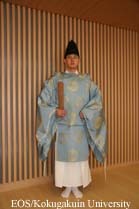- トップ
- Encyclopedia of Shinto
- Shinshoku no shōzoku
Encyclopedia of Shinto
| Main Menu: | |
| Links: |
詳細表示 (Complete Article)
| カテゴリー1: | 4. Jinja (Shrines) |
|---|---|
| カテゴリー2: | Ritual Implements and Vestments |
| Title | Shinshoku no shōzoku |
| Text | Vestments worn by Shinto priests (shinshoku), specifically, attire worn on ceremonial or ritual occasions. In the ancient period, formal clothing styles called raifuku and chōfuku were imported from the Asian continent, but after the cessation of missions to the Tang court, distinctive Japanese styles of attire developed, and the previous nae shōzoku (soft or flowing) style of garments evolved into the later kowa shōzoku (hard or stiff) style. These included the formal sokutai and ikan styles for men, and the itsutsuginu, karaginu, mo (the so-called "12-layered" or jūnihitoe dress), uchiki and hakama styles for women. Following the Meiji Restoration (1868), these styles were designated for ritual use. Vestments worn by male priests are classified as formal ikan (seisō), ritual saifuku (reisō), and everyday kariginu or jōe (jōsō ) styles. In contrast, female priests wear vestments based on the style of attire called uneme fuku worn by female palace attendants (nyokan). See also Seisō, reisō, jōsō . — Motosawa Masashi |







